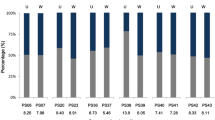Abstract
Sixty home made wine and sixty-four grape samples were collectedfrom five territories in Jordan, where grapes and wine aremostly producted. The collected samples were analyzed for themost used organochlorine pesticides (OCP) and organophosphorouspesticides (OPP) in Jordan, as well as for four heavy metals(Ni, Cu, Zn and Pb). The results showed that OCPs residues weredetected in 73% of the wine samples but no OPPs residue weredetected which is due to generally shorter half life of thelater pesticide. Grapes showed higher incident of contaminationthan wine, however, OCPs and OPPs with both short and longhalf-lives were detected. The OPPs were detected in only8.3% of the analyzed grape samples. Heavy metals showed higher valuesin grapes than in the wine samples and it was attributed toremoval of solids during wine preparation processes or throughcontamination of wine during storage. Most of the samples werebelow toxic limit.
Similar content being viewed by others
References
Adedeji, F. O.: 1983, Chlorinated hydrocarbon residue in Abandoned Cocoa Farms in Nigeria, Environ. Poll. (Ser. B) 6, 173–179.
Agnihorti, N. P., Jain, H. K. and Gajbhiye, V. T.: 1986, Persistence of some synthetic pyrethroid insecticides in soil, water and sediment, Part I, J. Et. Res. 10, 147–151.
Al-Oklah, K.: 1998, Determination of pesticides residue levels in the processed tomato and the impact of processing on residue in Jordan, M.Sc thesis, University of Jordan.
Al-Omar, M., Abdul-Jalil, F. H., Al-Ogaily, N. H., Tawfiq, S. J. and Al-Bassomy, M. A.: 1986, A Follow-Up Study of Maternal Milk Contamination with Organochlorine Insecticide Residue, Environ. Pollut. (Series B) 42, 79–91.
Becker, G.: 1979, Eine Multimethode zur gleichzeitigen Erfassung von 75 Pflanzenbehandlungsmitteln auf pflanzichem Dtsch. Lebensm. Runsch. 75, 148.
Bowmer, K. H.: 1991, Atrazin persistance and toxicity in 22 irrigated soils of Australia, Aust. J. Soil Res. 29, 339–350.
El-Zorgani, G. A.: 1976, Persistence of organochlorine insecticides in the field of Gerzira soil under cotton, Bull. Environ. Contam. Toxicol. 15, 378–382.
Fernandez, M.-A., Hernandez, L. M., Gonzalez, M. J. and Taberu, M. C.: 1992, Organochlorinated compounds and selected metals in water and soil from Dodana national park (Spain), Water, Air, and Soil Pollut. 65, 293–305.
Fritzsimone, R., Ek, M. and Eriksson, K.-E.: 1990, Anaerobic Dechlorination of Chlorinated Organic Compounds of Different Molecular Masses in Bleached plant Effluents, Environ. Sci. Technol. 24, 1744.
Giardi, M. T., Giardinia, M. C. and Filaccioni, G.: 1985, Chemical and Biological Degredation of Primary Metabolites of Atrazine by Nocardia, Agric. Biol. Chem. 49(6), 1551–1558.
Gibson, S. A. and Suflita, J. M.: 1990, Anaerobic biodegradation of 2, 4, 5-trichlorophenoxyacetic acid in samples from a methanogenic aquifer: Stimulation by short-chain organic acids and alcohol, Appl. Env. Microbiol. 6(6), 1825–1832.
Jiries, A.: 1998, Hydrochemistry of springs and groundwater as affected by human activities in Karak-Jordan, Accepted for publication in Hydrologie und Umwelt.
Kohnen, R.: 1974, Der Abbau des Insektizids lindan durch Microorganismen des Bodens. Diss. TU Braunschweig.
Lazaro, R., Herrera, A., Arino, A., Conchello, M. P. and Bayyari, S: 1996, Organochlorine pesticide residue in total diet samples from Aragon (northeastern Spain). J. Agric. Food Chem. 44, 2742–2747.
Anonymous: 1996, Ministry of Agriculture, Annual Report, Amman, Jordan.
Ministry of Environment and Municipal Affairs: 1994, Annual Agricultural Report, Amman-Hordan.
Mustafa, T. M. and Rufa'i, J. H.: 1994, Residue of Pyrazophos in cucamber in the central highlands of Jordan, Dirasat, 21B, 7–14.
Neideret, E., Trotman, R. B. and Saschenbrecker, P. W.: 1994, Levels and incidents of pesticides residue in selected agricultural food commodities in Canada, J. AOAC Inter. 77(1), 18–33.
Rao, D. M. R. and Murthy, A. S.: 1980, Persistence of endosulfan in soils, J. Agric. Food Chem. 28,1099–1101.
Swiss Standard: 1993, No. 3, Richtlinien 30A.
Thier, H. P. and Zeumer, H.: 1987, Manual of Pesticide Residue Analysis, Vol. 1, Deutsche Forschungsgemeinschaft.
Voss, G. and Geissbuehler, H.: 1971, Rate of degradation of phosphamidon and residue values, Residue Rev. 37, 133–152.
Author information
Authors and Affiliations
Corresponding author
Rights and permissions
About this article
Cite this article
Al Nasir, F.M., Jiries, A.G., Batarseh, M.I. et al. Pesticides and Trace Metals Residue in Grape and Home made Wine in Jordan. Environ Monit Assess 66, 253–263 (2001). https://doi.org/10.1023/A:1006356101118
Issue Date:
DOI: https://doi.org/10.1023/A:1006356101118




